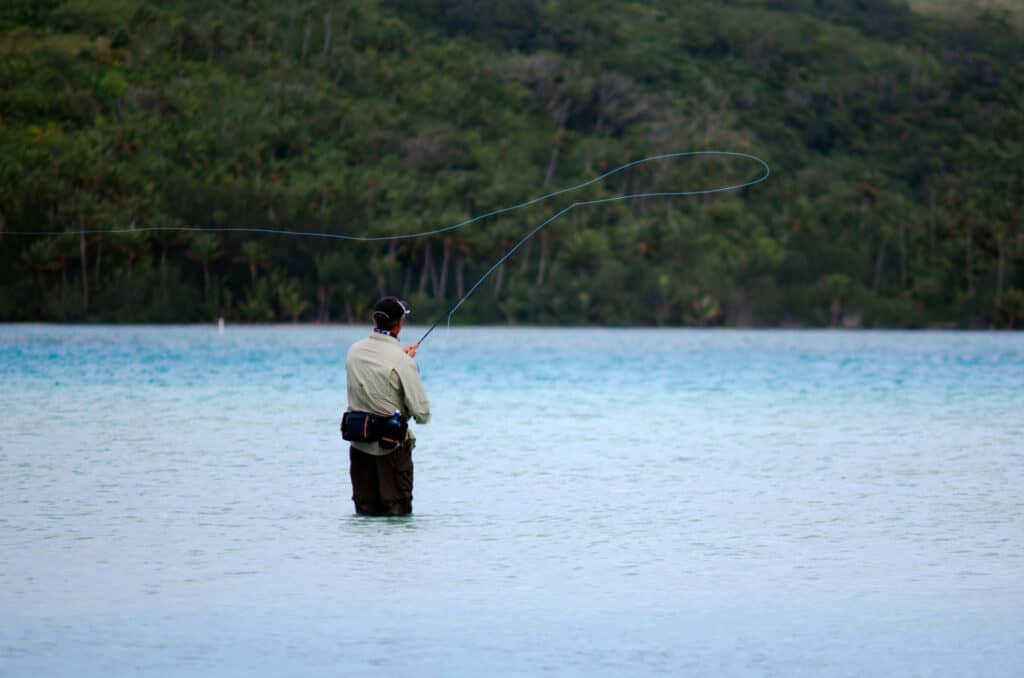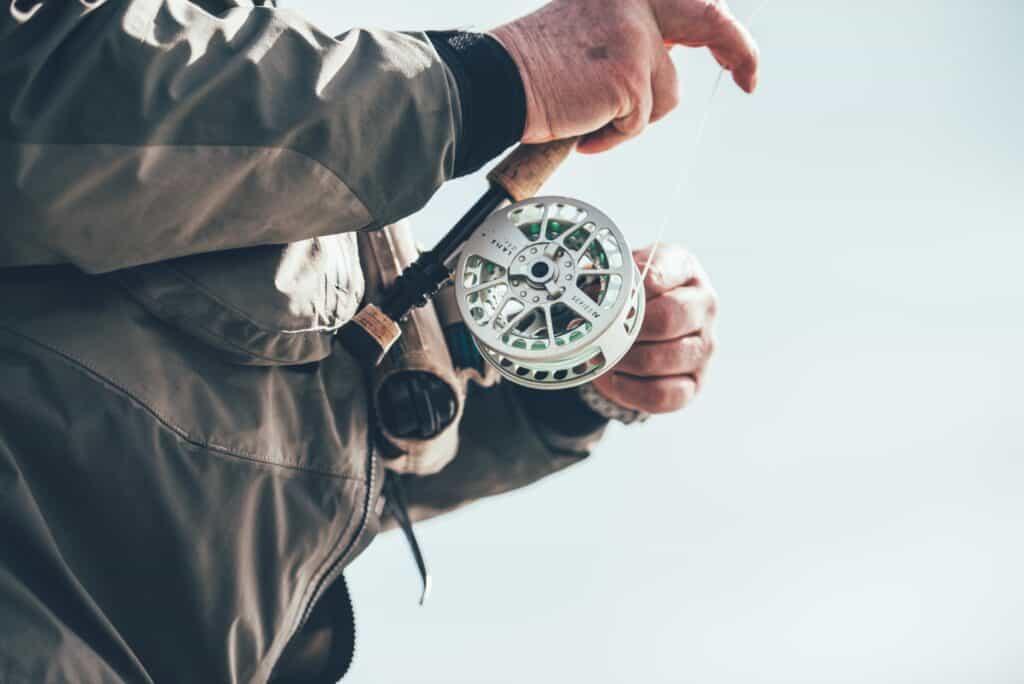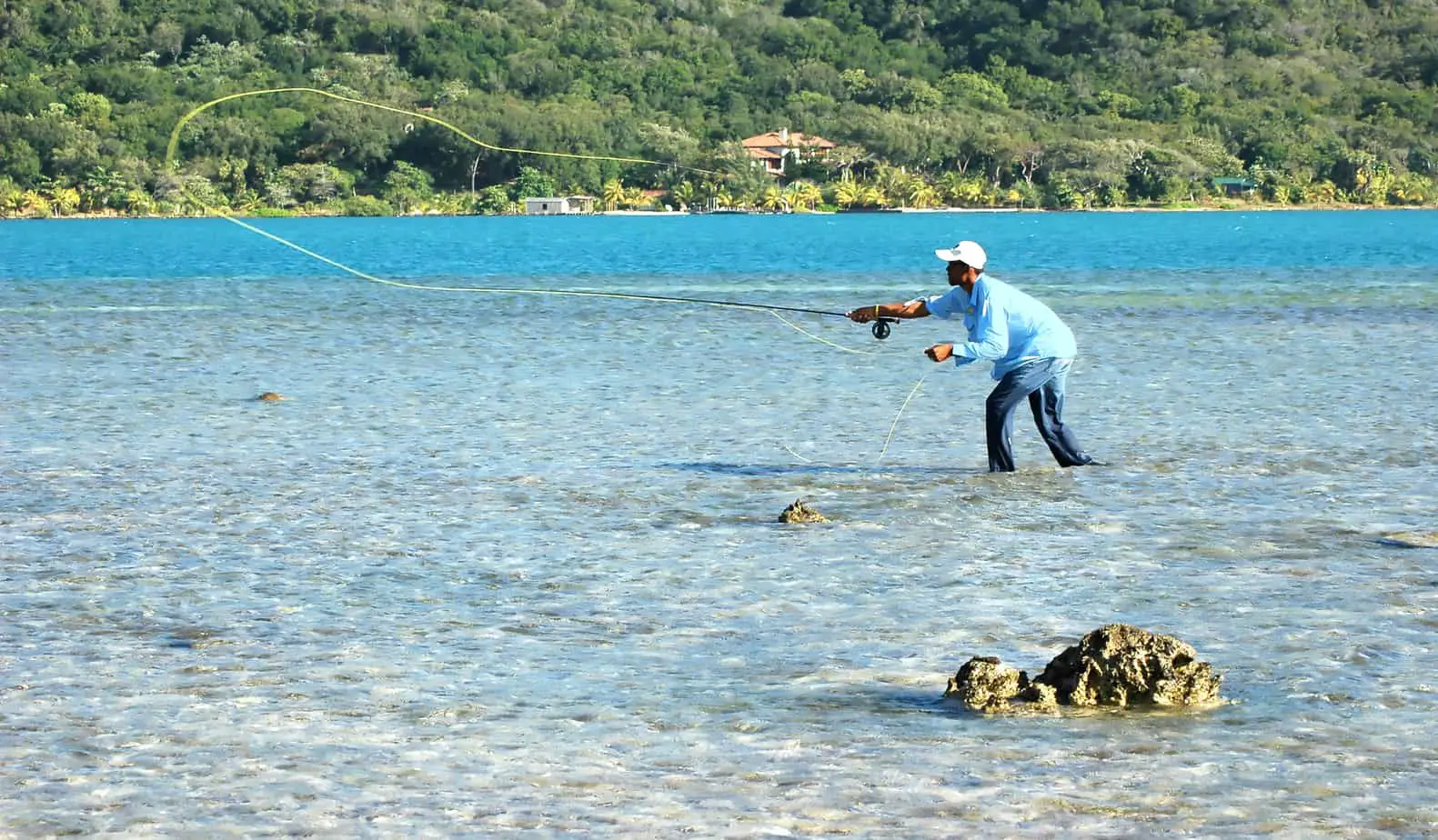Saltwater fly fishing is becoming increasingly popular. If you have never had the opportunity to try saltwater fly fishing, you may be wondering, “Is saltwater fly fishing different from freshwater fly fishing?”
The basic principles of fly fishing remain unchanged when fly fishing in saltwater. But in practice, saltwater fly fishing can be very different from freshwater because of the different gear, the fish species, and the techniques.
Saltwater Fly Fishing Gear
Saltwater fly fishing demands equipment that withstands elements of the ocean. Saltwater will corrode fly fishing gear fairly quickly.
Larger fly rods and reels, heavier fly lines, and stronger hooks are necessary to land saltwater fish. Although some saltwater fish are similar to larger freshwater species, many saltwater fish would ruin smaller freshwater tackle.
Five to eight weight rods and reels are used for smaller inshore species like redfish, trout, and small snook. In comparison, ten to twelve weight rods are used for large coastal species like sharks and large tarpon or offshore species such as cobia and amberjack.
Be sure to use fly lines with correct weights (seven to eight weight line for seven to eight weight reels).
There are lots of brands to choose from in fly fishing gear. Read “Is Orvis A Good Fly Fishing Brand?” or check out Trident Fly Fishing to explore your options.
Saltwater fly size differs from freshwater patterns too. Depending on target species, saltwater flies can range in size from a quarter tied on a size six hook up to a seven-inch fly tied on a 6/0 hook.
There also seems to be a limited color spectrum in freshwater, but in saltwater, all colors are used, and sometimes the more outlandish, the better. Check out the popular “nuclear chicken” or “electric chicken” on Amazon to see what we mean.
Popular Saltwater Fly Fishing Species
Saltwater fly fishing provides anglers a chance to wrestle with some of the most aggressive and strongest fish on the planet. An eight-pound bonefish will put the best equipment to its test, as will a hundred-pound tarpon. Each species has unique fighting characteristics, and pound for pound hold their own on the end of a fly line.
Even billfish can be caught on the fly rod.
Considerations for each fish vary as far as not just tackle or fly selection, but tactics too.
Saltwater fishing is almost always sight-casting, and this means stealth is mandatory. Wind, the sun glare, current speed and direction, and direction of the fish are all variables that have to be considered when approaching a saltwater gamefish.

Popular Saltwater Fly Patterns
There are countless saltwater fly patterns out there, with new designs coming out almost every day. Some patterns have withstood the test of time and consistently produced fish, while others are simply more for the angler’s personal preference.
Saltwater fish mainly prey on baitfish, shrimp, and crabs. Other food sources include clams, barnacles, eels, and worms.
The Clouser Minnow is probably the most world-renowned saltwater fly pattern. It is designed to imitate a baitfish and is typically tied with two different bucktail colors and a set of lead dumbbell eyes.
Merkin Crabs are a go-to for redfish anglers. However, anything that eats crabs will eat a Merkin Crab. They range in various sizes from little dimes to half dollars.
Our favorite saltwater fly is a gurgler. Gurglers are a topwater pattern with a foam mouth/body that chugs and pushes a lot of water. They can be tied in various sizes and colors and imitate fish feeding on shrimp or baitfish.
The seducer is another classic saltwater pattern. Again tied in various sizes and colors, it is meant to imitate baitfish or shrimp.
Saltwater Fly Fishing Locations
Location is always an essential variable. When saltwater fly fishing, the angler must select an area with the following.
- Moving water
- Signs of fish or bait
- Structures
Moving water means oxygenated water and food supply. Moving water also helps fly presentation. Predatory fish often lay in wait, hoping the current delivers a tasty meal.
There are various tide charting apps, or you can simply Google your location’s tides for that day. Look for strong tide swings as this is when both the bait and the fish will be most active.
An obvious but sometimes overlooked location is where the bait is. Shrimp jumping, baitfish jumping, or merely seeing baitfish schools indicate there might be fish nearby.
Seeing the fish is another good location; as mentioned, saltwater fly-fishing is mostly sight-casting. Look for tailing fish, fish busting bait, or wakes and swirls.
All anglers universally recognize structures as an excellent area to find fish. Saltwater fly anglers should target docks, rocks, pilings, jetties, mangroves, and obvious bottom topography such as cuts and drop-offs.
The Saltwater Fly Fishing Approach
Saltwater fly fishing has two different approaches: wading or by boat. Wading allows the angler the most stealth approach as there are no sounds of water lapping against the boat or any reverberations from walking or dropping equipment on the boat deck.
The main disadvantage to wading is it limits the angler to where they can fish. One because of accessing wading areas, and two because an angler can only go so deep before they cannot cast.
Using a boat, kayak, or stand up paddleboard, allows the fly angler to access a variety of areas that shorebound anglers cannot reach. The main disadvantage to using a boat is it can be noisy; the angler can go only to sites where the boat is designed to go. A kayak can’t go offshore, and a bay boat can’t go into six inches of water.
Nine out of ten times, an inshore fly angler will be positioned on the bow of a skiff while a guide or friend uses a push-pole off the back of the boat to locate and approach fish stealthily.
If it is your first-time saltwater fly fishing, consider hiring a guide. Read our article, “Should I Hire A Fly Fishing Guide?”
When fly fishing, the fly line can get caught on anything and everything on a boat’s surface. However, using a boat definitely gives the angler the advantage as they can cover more water and go to areas where the fish may be out of reach of the wading angler.
You can also combine these two approaches. A boater can cruise to a location, drop an anchor, and hop out and wade to the fish if it is shallow enough.

Saltwater Fly Fishing Laws & Etiquette
There can be fairly strict rules and regulations with fly fishing for trout in different areas (barbless hooks, target species, etc.) Freshwater fly fishing generally follows conventional angling rules and regulations regarding size and bag limits.
However, with saltwater fly fishing, some unwritten rules and regulations should be noted.
Saltwater fly anglers must pay attention to other fly anglers and note what direction they are moving. Nothing will upset a guide more than motoring up to a shoreline fifty yards in front of him and starting to fish.
Another consideration is to distance yourself in general. The ocean is a big place. If an angler is fishing a flat, go find another flat to fish or somewhere else. Fly fishing requires a lot of space and a lot of stealth.
Knowing your seasons and how many fish you can keep is important, but it is just as important to understand fishing etiquette.
Saltwater fly fishing does not have specifics as there are with trout in streams, so just look up your state and region’s rules, and you should be fine.
However, if you are looking to set records, be sure to check out IGFA’s website for the strict line weights, rod and reel weights, leader lengths that meet their standards.
Conclusion
Saltwater fly fishing is quite the experience.
Saltwater fly fishing has the same challenges as freshwater, plus the additional challenges of targeting fish that are as big as a grown man. It can be a very surreal experience.
Going to a local fly shop is the first step in saltwater fly fishing.
Once you are geared up for the species you are targeting, simply look for structure, bait, or the fish themselves and be ready to hold on tight.
Checking your tides is a good idea, too, whether you are boating or wading. Avoid slack tide where the water is not moving. And you don’t want to be out on a flat when the tide is low at your ankles and high at your chest.
Lastly, be mindful of other anglers on the water. Everyone is out there for the same reason- to lay a fly in front of a big fish and create an experience that will live on forever. Don’t ruin it for each other.
Good luck, and have fun!


